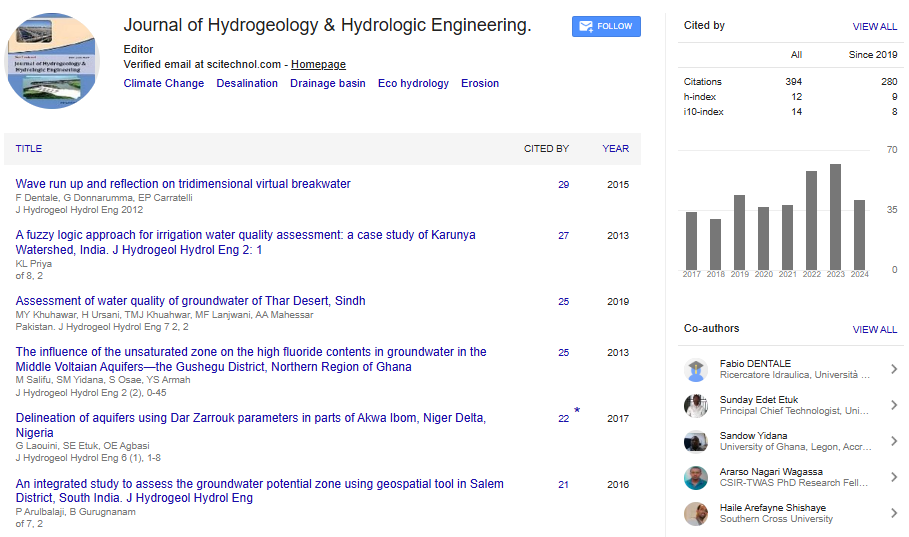Opinion Article, J Hydrogeol Hydrol Eng Vol: 13 Issue: 6
Optimizing Water Resources Through Irrigation Hydrology
Isabella Rossi*
1Department of Applied Hydrology, Kyoto University, Kyoto, Japan
*Corresponding Author: Isabella Rossi,
Department of Applied Hydrology, Kyoto
University, Kyoto, Japan
E-mail: rossii378@gmail.com
Received date: 26 November, 2024, Manuscript No. JHHE-24-154129;
Editor assigned date: 28 November, 2024, PreQC No. JHHE-24-154129 (PQ);
Reviewed date: 12 December, 2024, QC No. JHHE-24-154129;
Revised date: 20 December, 2024, Manuscript No. JHHE-24-154129 (R);
Published date: 27 December, 2024, DOI: 10.4172/2325-9647.10003
Citation: Rossi I (2024) Optimizing Water Resources through Irrigation Hydrology. J Hydrogeol Hydrol Eng 13:6.
Description
Irrigation hydrology plays a pivotal role in ensuring water resources are effectively managed for agricultural productivity. As global populations grow and climates shift, the demand for sustainable water use in agriculture becomes increasingly precarious. By investigating into the principles of irrigation hydrology, we can enhance water distribution, maximize crop yields and minimize environmental impacts.
Irrigation hydrology focuses on the movement, distribution and management of water for agricultural purposes. This field blends principles from hydrology, soil science and crop management to create systems that deliver water efficiently and sustainably. A well-designed irrigation system considers the availability of water sources, the requirements of specific crops and the physical properties of the soil.
Key aspects of irrigation hydrology include understanding water flow in surface and subsurface systems, assessing water quality and determining the irrigation needs of various crops based on climatic and soil conditions. Proper implementation ensures that plants receive adequate moisture without waterlogging or overuse of resources.
Techniques and technologies in modern irrigation
Advancements in technology have revolutionized irrigation methods. Traditional systems such as flood irrigation are now complemented or replaced by more efficient methods like drip irrigation and sprinkler systems. These modern techniques allow precise water delivery, reducing waste and promoting conservation.
Drip irrigation: This method delivers water directly to the roots of plants using a network of tubes and emitters. It minimizes evaporation and runoff, making it ideal for arid regions.
Sprinkler systems: Designed to simulator rainfall, sprinklers distribute water evenly across fields. They are particularly effective for crops requiring uniform moisture.
Smart irrigation: With the integration of sensors, weather forecasts and automated controls, smart irrigation systems optimize water usage by responding to real-time conditions.
Challenges in irrigation hydrology
Despite its importance, irrigation hydrology faces several challenges. Water scarcity is a significant concern, especially in regions where demand exceeds supply. In addition, inefficient irrigation practices can lead to waterlogging, soil salinization and depletion of local water resources.
Climate change exacerbates these issues by altering precipitation patterns and increasing the frequency of extreme weather events. As a result, irrigation systems must adapt to fluctuating water availability and ensure flexibility against droughts and floods.
Sustainable approaches to irrigation
Sustainability is at the heart of modern irrigation hydrology. Farmers and water managers are adopting practices that balance agricultural needs with environmental protection.
Rainwater harvesting: Collecting and storing rainwater reduces dependence on groundwater and ensures a reliable water supply during dry periods.
Soil moisture management: Monitoring soil moisture levels helps determine when and how much water to apply, preventing overirrigation.
Crop selection: Choosing drought-resistant or water-efficient crops can reduce the demand for irrigation in water-scarce areas.
Effective irrigation hydrology also relies on supportive policies and education. Governments and organizations must promote water conservation initiatives, invest in research and provide training for farmers on best practices. Public awareness campaigns can further emphasize the importance of sustainable water use in agriculture.
Conclusion
Irrigation hydrology is vital for addressing the challenges of water resource management in agriculture. By implementing innovative techniques, addressing challenges and promoting sustainable practices, this field contributes to food security and environmental sustainability. As we look to the future, continued advancements in irrigation hydrology will be essential for meeting the needs of a growing global population while preserving the planet’s finite water resources.
 Spanish
Spanish  Chinese
Chinese  Russian
Russian  German
German  French
French  Japanese
Japanese  Portuguese
Portuguese  Hindi
Hindi 
